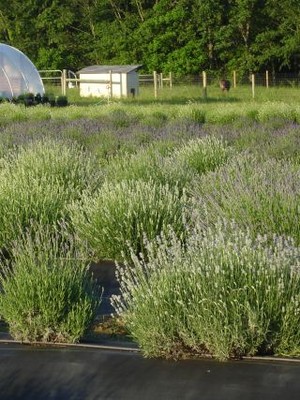24 Apr Fri 2009
What is you favorite lavender variety?
Peaceful Acres loves to share and enjoy the beauty of lavender . Choose your favorite variety and help us decide next years 4 acre planting. The farm currently grows 8 variety's of lavender. If you have a New cold weather lavender angustifolia variety and would like to share it, please do so I would love hearing from lavender lovers!

LAVANDULA STOECHAS ('Spanish lavender')
Off the Mediterranean coast France is a group of islands once called the Stoechades by the Greeks, and from which this group of lavender derives its name. The flower heads are characterized by what look like extra petals on top of the flower head. Sometimes called rabbit ears or wings, their correct name is sterile bracts. These plants bloom throughout the summer. The foliage of L. stoechas has camphor scent.
LAVANDULA x INTERMEDIA (Sometimes called 'lavandins')
This species is a natural hybrid of L. angustifolia and L. latifolia, unfortunately all are sterile. Colors are primarily shades of violets and purples although there are a few white varieties. Lavandula x Intermedia hybrids have several members which are winter hardy to zone 5. Their essential oil can be five times that of L. angustifolia. They tend to bloom several weeks later than L. angustifolia and often bloom twice in the season. Many of these varieties are bred so the dried buds fall easily from the stems. This makes collecting dried buds simple.
LAVANDULA ANGUSTIFOLIA (L. vera, L. officinalis, true lavender, L. spica, Dutch lavender, English lavender)
These are known as English lavenders. One of the largest lavender species, it contains the most winter-hardy and colorful varieties. Some are small enough for the rock garden, others large enough to make a statement! The earliest lavenders to bloom in the garden, most will bloom in June or July and again in August and September.
Lavandula x Intermedia 'GROSSO'
Plant height: 28"
Flowering height: 40"
Bud 'Grosso' was discovered in France in 1972. At the time, L x intermedia 'Abrialii' was commonly grown for oil, and being affected by disease. Someone noticed how healthy the 'Grosso' plants were, and gradually it became the popular commercial variety.
Lavandula angustifolia 'ENGLISH' (L. vera, L. officinalis, true lavender, L. spica, Dutch lavender, English lavender)
Plant height: 18"Flowering height: 24"
Bud 'TWICKLE PURPLE'
Plant height: 24-38"
Flowering height: 34-40"
Bud 'NANA' ('Dwarf White,' 'Baby White')
Plant height: 12-16"
Flowering height: 14-20"
Bud 'ROSEA'
Plant height: 24-48"
Flowering height: 30-35"
Bud 'LADY' ('Lavender Lady')
Plant height: 16-20"
Flowering height: 20-24'
Bud 'Munstead,' they bred the plants until they produced lavender that would grow true to type from seed and bloom in the first year. This is quite an achievement, as most lavenders, whether started as cuttings or from seed, bloom in the second year. To achieve bloom in the first year, you need to start the seed indoors in January or February. It benefits from pruning to keep its size and shape.
Lavandula angustifolia 'HIDCOTE' ('Hidcote Blue,' 'Hidcote purple')
Plant height: 24-48"
Flowering height: 28-32"
Bud 'MUNSTEAD' ('Munstead Blue,' 'Munstead Dwarf')
Plant height: 12-16"
Flowering height: 16-20"
Bud 'Munstead' is the most winter hardy of all the lavenders. Although shown here as winter hardy to zone 5. Grown since the early 1900's. Flowers tend to appear bunched in a group about 1" long at the top of the flower spike.
All about "Growing Lavender" purchase on our website or our Lavender Gift Shop.


